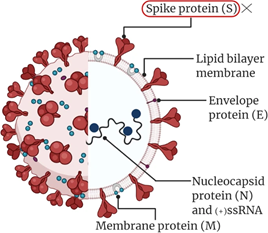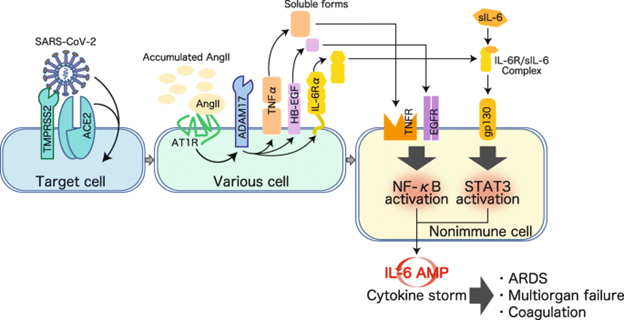Flavonoids are secondary plant metabolites capable of exhibiting a range of biological activities, including anti-viral, anti-inflammatory, and immuno-modulatory activities. Interestingly, some of these activities have shown noteworthy abilities that depict their potential to manage the Covid-19 disease initiated by the Sars-Cov-2.
A cartoon-like illustration of the main structural features of SARS-CoV-2. The red frame and cross sign indicates a critical

Huang et al (2020a) reported flavonoids such as quercetin, kaempferol, luteolin and naringenin as able to manage Sars-Cov-2 infection by inhibiting its viral adsorption and replication as well as regulating the host’s inflammatory mediators, exhibiting anti-inflammatory activities, and controlling the immune system to prevent a cytokine storm that can damage the target organs. Rutin was discovered to decrease IL-6 production – a Covid 19 inflammatory mediator (Niu et al., 2021). Quercetin was found to be applicable in combating Sars-Cov-2 through its ACE2 downregulation, as Sars-Cov-2 spike-protein binds to the ACE-2 receptors of the host cells for entry (Niu et al., 2020). Ruan et al., 2020 noted affinity between kaempferol, quercetin, and naringenin and its target genes (IL-6, IL1β, and CCL2) as a mechanism in attenuating inflammatory storms and regulating the immune function. This activity shows these flavonoids’ potential to act similarly when applied with Sars-Cov-2 as an inflammatory storm also occurs in its pathogenesis.
Diagram showing how Sars-Cov-2 initiates an inflammatory/cytokine storm

Credit: Hojyo et al., 2020
Quercetin and luteolin were reported to exhibit anti-inflammatory activity against interleukin 6 (a Covid 19 inflammatory mediator) (Wang et al., 2020). Quercetin, kaempferol, and luteolin were reported to potentially influence mechanisms elevating immunity, inhibiting inflammatory stress, and modulating inflammatory responses aside from others as part of their possible role against Sars-Cov-2 infection (Huang et al., 2020b). Hesperidin was observed to have exhibited immunoregulatory, anti-inflammatory and multi-organ protective abilities which could be employed in managing Covid-19 (Zhao et al., 2021). Luteolin reduces macrophage infiltration and modulation of the inflammatory response (Kwon and Choi, 2018), a potential activity that can combat Covid-19.
Myricetin attenuates the NLRP3 inflammasome assembly (Chen et al., 2019), which can cause lung inflammation in SARS-CoV-2 infection. Hesperidin was found to suppress high levels of angII in hypertensive rats models (Wunpathe et al., 2018). This angiotensin 2-lowering activity can be used against Sars-Cov-2 as its spike protein targets angII for viral entry into the host cell during infection. Moreso, these receptors are found throughout the human body, though mostly in the lungs (type 2 pneumocytes), hence their downregulation will significantly reduce a host’s risk of contracting covid or reducing its symptoms for the already contracted. Kaempferol exerted anti-inflammatory effects mediated by a decrease in angII-induced collagen accumulation in cardiac fibroblasts (Du et al., 2019). This activity can potentially inhibit inflammatory storms in Sars-cov-2 infection.
Flavonoids can target 3CLpro of Sars-Cov-2 as a strategy against Covid-19. Sharma et al., 2020 revealed quercetin and myricetin as potent inhibitors of 3CLpro. da Silva et al., 2020 also showed rutin to have inhibited 3CLpro activity. Hesperidin exhibited immunomodulatory activity on gut-associated lymphoid tissue and reinforced its prebiotic role (Estruel-Amades et al., 2019). Therefore, it shows the potential to strengthen a host immunity against Covid-19.
Based on the enumerated potential anti-sars-cov-2 activities, it can be boldly suggested that flavonoids really have the great potential to combat Covid 19. Nevertheless, more human studies are required to strengthen these claims.
REFERENCES
- Ngwa, W., Kumar, R., Thompson, D., Lyerly, W., Moore, R., Reid, T. E., … & Toyang, N. (2020). Potential of flavonoid-inspired phytomedicines against COVID-19. Molecules, 25(11), 2707.
- Huang, Y. F., Bai, C., He, F., Xie, Y., & Zhou, H. (2020a). Review on the potential action mechanisms of Chinese medicines in treating Coronavirus Disease 2019 (COVID-19). Pharmacological research.
- Niu, W., Wu, F., Cui, H., Cao, W., Chao, Y., Wu, Z., … & Liang, C. (2020). Network Pharmacology Analysis to Identify Phytochemicals in Traditional Chinese Medicines That May Regulate ACE2 for the Treatment of COVID-19. Evidence-Based Complementary and Alternative Medicine, 2020.
- Niu, W. H., Wu, F., Cao, W. Y., Wu, Z. G., Chao, Y. C., Peng, F., & Liang, C. (2021). Network pharmacology for the identification of phytochemicals in traditional Chinese medicine for COVID-19 that may regulate interleukin-6. Bioscience reports, 41(1), BSR20202583.
- Ruan, X., Du, P., Zhao, K., Huang, J., Xia, H., Dai, D., … & Zhang, J. (2020). Mechanism of Dayuanyin in the treatment of coronavirus disease 2019 based on network pharmacology and molecular docking. Chinese Medicine, 15(1), 1-17.
- Wang, M., Fu, D., Yao, L., & Li, J. (2020). Theoretical Study of the Molecular Mechanism of Maxingyigan Decoction Against COVID-19: Network Pharmacology-based Strategy. Combinatorial Chemistry & High Throughput Screening.
- Huang, Y., Zheng, W. J., Ni, Y. S., Li, M. S., Chen, J. K., Liu, X. H., … & Li, J. Q. (2020b). Therapeutic mechanism of Toujie Quwen granules in COVID-19 based on network pharmacology. BioData mining, 13(1), 1-21.
- Zhao, J., Tian, S., Lu, D., Yang, J., Zeng, H., Zhang, F., … & Zhang, W. (2021). Systems pharmacological study illustrates the immune regulation, anti-infection, anti-inflammation, and multi-organ protection mechanism of Qing-Fei-Pai-Du decoction in the treatment of COVID-19. Phytomedicine, 85, 153315.
- Kwon, E. Y., & Choi, M. S. (2018). Luteolin targets the toll-like receptor signaling pathway in prevention of hepatic and adipocyte fibrosis and insulin resistance in diet-induced obese mice. Nutrients, 10(10), 1415.
- Chen, H., Lin, H., Xie, S., Huang, B., Qian, Y., Chen, K., … & Wu, Y. (2019). Myricetin inhibits NLRP3 inflammasome activation via reduction of ROS-dependent ubiquitination of ASC and promotion of ROS-independent NLRP3 ubiquitination. Toxicology and applied pharmacology, 365, 19-29.
- Wunpathe, C., Potue, P., Maneesai, P., Bunbupha, S., Prachaney, P., Kukongviriyapan, U., … & Pakdeechote, P. (2018). Hesperidin suppresses renin-angiotensin system mediated NOX2 over-expression and sympathoexcitation in 2K-1C hypertensive rats. The American journal of Chinese medicine, 46(04), 751-767.
- Du, Y., Han, J., Zhang, H., Xu, J., Jiang, L., & Ge, W. (2019). Kaempferol prevents against ang II-induced cardiac remodeling through attenuating ang II-induced inflammation and oxidative stress. Journal of cardiovascular pharmacology, 74(4), 326.
- Sharma, A., Goyal, S., Yadav, A. K., Kumar, P., & Gupta, L. (2020). In-silico screening of plant-derived antivirals against main protease, 3CLpro and endoribonuclease, NSP15 proteins of SARS-CoV-2. Journal of Biomolecular Structure and Dynamics, 1-15.
- da Silva, F. M. A., da Silva, K. P. A., de Oliveira, L. P. M., Costa, E. V., Koolen, H. H., Pinheiro, M. L. B., … & de Souza, A. D. L. (2020). Flavonoid glycosides and their putative human metabolites as potential inhibitors of the SARS-CoV-2 main protease (Mpro) and RNA-dependent RNA polymerase (RdRp). Memórias do Instituto Oswaldo Cruz, 1-15.
- Estruel-Amades, S., Massot-Cladera, M., Pérez-Cano, F. J., Franch, À., Castell, M., & Camps-Bossacoma, M. (2019). Hesperidin effects on gut microbiota and gut-associated lymphoid tissue in healthy rats. Nutrients, 11(2), 324.
- Alzaabi, M. M., Hamdy, R., Ashmawy, N. S., Hamoda, A. M., Alkhayat, F., Khademi, N. N., … & Soliman, S. S. (2021). Flavonoids are promising safe therapy against COVID-19. Phytochemistry Reviews, 1-22.